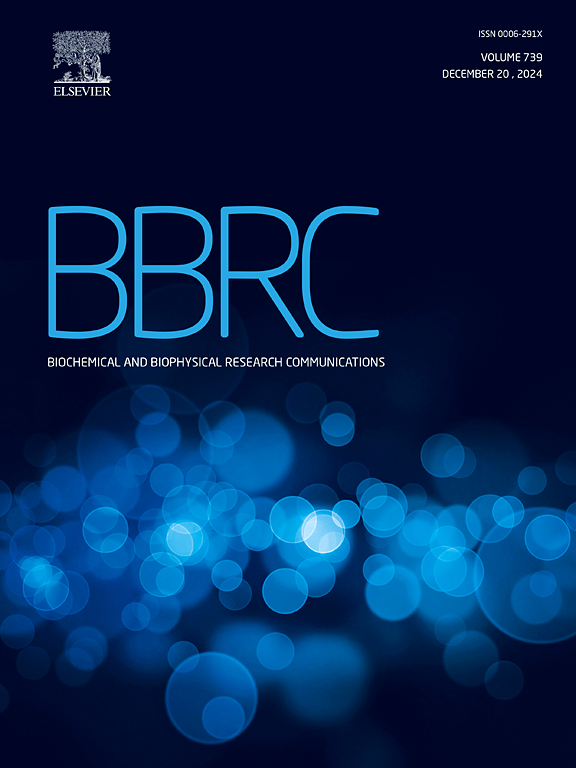Novel interaction with PSMD9 regulates DNAJA1 turnover and mitochondrial polarity
IF 2.2
3区 生物学
Q3 BIOCHEMISTRY & MOLECULAR BIOLOGY
Biochemical and biophysical research communications
Pub Date : 2025-05-19
DOI:10.1016/j.bbrc.2025.152051
引用次数: 0
Abstract
Understanding protein-protein interactions in cancer is essential for the development of innovative therapeutic strategies. Chaperone proteins often form cooperative networks that regulate key cellular processes, many of which are disrupted in cancer, offering potential targets for intervention. PSMD9, a chaperone involved in 26S proteasome assembly, is frequently overexpressed in various cancers and is linked to resistance to chemotherapy and radiotherapy. It also plays roles in intracellular signaling. Mass spectrometry analysis of proteins co-purified with PSMD9 revealed a subset containing a specific EXKK motif, suggesting potential direct interactions. Among these was DNAJA1, a chaperone involved in mitochondrial protein transport. This study explores and characterizes the interaction between PSMD9 and DNAJA1. The interaction was confirmed through in vitro binding assays using purified proteins and further validated by introducing mutations in DNAJA1 that disrupted the binding. Co-immunoprecipitation from MCF7 breast cancer cells supported the in-cell interaction. Upon proteasomal inhibition, interaction between PSMD9 and DNAJA1 was enhanced in MCF7 cells, correlating with increased DNAJA1 stability. Additionally, PSMD9 depletion led to elevated mitochondrial membrane potential, linking this interaction to mitochondrial regulation. Thus, beyond its known role in cytoplasmic proteostasis, PSMD9 may influence mitochondrial homeostasis via DNAJA1.
与PSMD9的新相互作用调节DNAJA1的周转和线粒体极性
了解癌症中蛋白质与蛋白质的相互作用对于创新治疗策略的发展至关重要。伴侣蛋白经常形成合作网络,调节关键的细胞过程,其中许多在癌症中被破坏,为干预提供了潜在的目标。PSMD9是一种参与26S蛋白酶体组装的伴侣,在各种癌症中经常过表达,并与化疗和放疗的耐药性有关。它还在细胞内信号传导中发挥作用。质谱分析显示,与PSMD9共纯化的蛋白含有特定的EXKK基序,表明可能存在直接相互作用。其中包括参与线粒体蛋白运输的伴侣蛋白DNAJA1。本研究探讨了PSMD9和DNAJA1之间的相互作用。这种相互作用通过使用纯化蛋白的体外结合实验得到证实,并通过在DNAJA1中引入破坏这种结合的突变进一步验证。MCF7乳腺癌细胞的共免疫沉淀支持细胞内相互作用。蛋白酶体抑制后,MCF7细胞中PSMD9和DNAJA1的相互作用增强,与DNAJA1稳定性增加相关。此外,PSMD9缺失导致线粒体膜电位升高,将这种相互作用与线粒体调节联系起来。因此,除了已知的在细胞质蛋白平衡中的作用外,PSMD9还可能通过DNAJA1影响线粒体稳态。
本文章由计算机程序翻译,如有差异,请以英文原文为准。
求助全文
约1分钟内获得全文
求助全文
来源期刊
CiteScore
6.10
自引率
0.00%
发文量
1400
审稿时长
14 days
期刊介绍:
Biochemical and Biophysical Research Communications is the premier international journal devoted to the very rapid dissemination of timely and significant experimental results in diverse fields of biological research. The development of the "Breakthroughs and Views" section brings the minireview format to the journal, and issues often contain collections of special interest manuscripts. BBRC is published weekly (52 issues/year).Research Areas now include: Biochemistry; biophysics; cell biology; developmental biology; immunology
; molecular biology; neurobiology; plant biology and proteomics

 求助内容:
求助内容: 应助结果提醒方式:
应助结果提醒方式:


